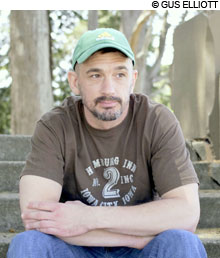
DOCTOR WITH A CURE Adrian’s monsters are the best monsters. |
Chris Adrian's novels puff you full of delight, then rip your heart out. Adrian's a sadist, maybe. Or maybe he's got the biggest heart of any living writer, so big that it can hold the sweetest thoughts alongside shame and also death — real death, in all its devastation and splendor.Grief sits at the center of each of Adrian's novels. This leaden core weighs on his characters' actions, paints their every ephemeral joy with ungodly sorrow. Gob's Grief, his first novel, set a somber precedent for his subsequent efforts: a boy rails against the death of his brother and the deaths of thousands of other brothers slain in the Civil War. The Children's Hospital, his second, follows suit: a brother's death hastens the destruction of the whole world. In each book, the delight comes when the bereaved pervert the natural order to sustain life. Is it a surprise that Adrian is a pediatrician?
Trying to categorize his literary work results in more perversion, this time of hyphens and genres. Gob's Grief might be called a historical-magical-realist-literary novel, The Children's Hospital an apocalyptic, serio-comic sci-fi/fantasy novel of ideas. It's tidier and more accurate just to call them genius.
Set in present-day San Francisco, his latest, The Great Night, boasts two dead siblings, a dead child, fairies, and a plot that borrows from and intersects with A Midsummer Night's Dream. Adrian casts Titania and Oberon as parents devastated over the death of a changeling from cancer. Oberon has fled the magic realm of Buena Vista Park. Titania is clinically depressed, shut away in her bower. She initiates the plot w hen, in hopes of escaping her despair, she sets Puck loose and sends her complement of fairies into a panic.
Little wonder they scatter — though Titania and Oberon are both monstrous, Puck is an actual monster:
People and fairies, animals and spirits — any observing entity — each saw Puck a little differently. What you saw depended on how you were feeling: he was often the image of one's worst fear or most troubling anxiety. . . . Some saw him as a sliver of flame, or a blackness heavier and darker than the black air, or a fluttering pair of dark wings. . . .
But Adrian's monsters are the best monsters. Although horrifying to contemplate, they anchor his phantasmagoric plots with a sense of fairy-tale familiarity. Puck, you see, wants to eat everyone, and nobody, with the exception of a few notable German fetishists, wants to be eaten.
Complicating matters, three dopey, brokenhearted San Franciscans stumble into Buena Vista Park at this very moment: Henry, a self-loathing, obsessive-compulsive pediatric oncologist; Will, a sexually compulsive tree doctor; and Molly, an anxious divinity-school dropout. The fun begins when they run into the fairies; the comic value of what happens when the workaday mentally ill collide with an enchanted grotesquerie should never be underestimated.